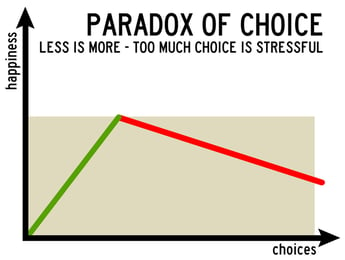 Buyers have a lot of choices today. More choices don’t necessarily yield better outcomes or more satisfaction. In the Jolt Effect, the authors cite The Paradox of Choice: Why More Is Less, psychologist Barry Schwartz's research revealing the problems with too many options.
Buyers have a lot of choices today. More choices don’t necessarily yield better outcomes or more satisfaction. In the Jolt Effect, the authors cite The Paradox of Choice: Why More Is Less, psychologist Barry Schwartz's research revealing the problems with too many options.
The Paradox of Choice
Watch the author Matt Dixon (1:09) explain reasons for recommending to your prospect:
In the Paradox of Choice Schwartz shares four reasons choice makes people miserable:
- As choice increases, so does the potential for making a bad choice. Anticipated-regret-effect leads to people sitting on the sidelines, making no choice. The more options you have, the more you tend to hit the pause button—or, step away altogether. Your prospect rationalizes, better to do nothing than make a bad purchase.
- Excessive choice undermines decision-making progress. Even when able to plan, we end up being less satisfied because we wonder whether we could have made a better choice. “Post-decision dysfunction” is a hallmark of customer indecision. Deciding is often not the end of a customer’s indecision; it’s just the beginning.
- Facing more options, the bar for what will satisfy us escalates, making us feel like we are “settling” on any option we choose. Satisficers are those individuals who are looking to max out certain attributes in a decision, whereas maximizers are looking to maximize all attributes. Watch
- Choice makes us unhappy; we blame ourselves when we feel we made the wrong choice. This is the error of commission. Early in the sale, it’s largely about convincing the customer how to avoid loss stemming from their inactions, the back half of the sale is how to avoid loss stemming from their actions.
The solution may feel obvious: pare down the choices so your prospect doesn’t struggle with the valuation problems leading to indecision.
It’s not that simple.
Two Skills Needed for Effective Recommendations: Proactive Guidance & Advocacy
At some point, high performers purposefully eliminate options from consideration and recommend to their customers what they should buy.
The first skill the authors call “proactive guidance.” The rep shifts from a reactive posture (i.e., “Help me understand your needs”) to a proactive posture (i.e., “Here’s what you need”).
Proactive guidance demonstrably influences win rates.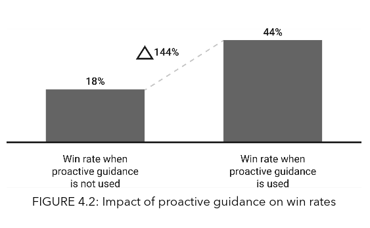
Win rates jump from 18 percent to 44 percent when reps used this one skill—an improvement of 144 percent (see Figure 4.2).
Proactive guidance may sound like a subtle nudge, a small direction offered to a customer. “This configuration is our most popular,” one rep explained.
Another “most of our new customers start with this plan and then upgrade later as their needs evolve.”
More powerful than making a general recommendation, the rep offers his or her personal recommendation.
This “advocacy” behavior suggests not just the rep personally advocating for a specific choice, but that the salesperson is on the customer’s side in making this decision.
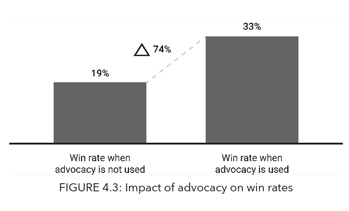 Star reps say to their customers, “Here’s what I would do if I were you” and “I always tell customers they can’t go wrong with X.”
Star reps say to their customers, “Here’s what I would do if I were you” and “I always tell customers they can’t go wrong with X.”
This advocacy technique can lift win rates by 74 percent (see Figure 4.3).
In combination, proactive guidance and advocacy are powerful ways to overcome valuation problems.
High performers use these techniques to break the “paradox of choice” Schwartz tells us can lead to purchasing regret, post-decision dysfunction, and, often, no decision at all.
Their analysis is shared in these graphs.
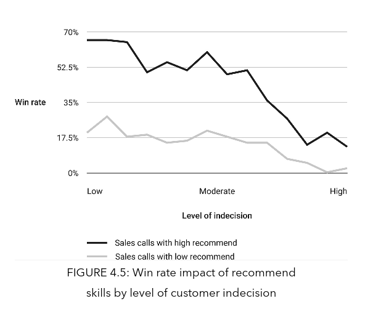 When prospects aren’t deeply indecisive, these “recommend” techniques improve win rates substantially.
When prospects aren’t deeply indecisive, these “recommend” techniques improve win rates substantially.
In instances in which customers experience low levels of indecision when recommend skills are demonstrated at a high level compared to a low level, there’s a 240 percent difference in win rates (see Figure 4.5).
Avoid Amplifying Indecision
Recommendations can overcome the customer’s indecision about what to choose. It’s more important to know what to avoid doing.
Average performers handle customer indecision with more questions: “What’s important to you?” “What are you looking for in a solution?” “Are there questions I can answer for you that would help you decide?”
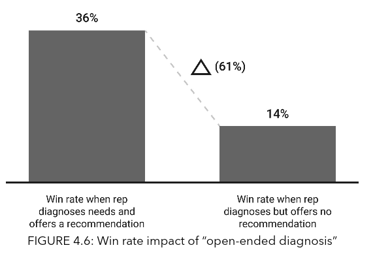 Instead of leading the customer to a decision, they defer to the customer, allowing indecision to run rampant.
Instead of leading the customer to a decision, they defer to the customer, allowing indecision to run rampant.
When a customer is stumped about which option is right, this approach backfires, and significantly so.
When reps diagnose needs and offer their personal recommendation, win rates are 36 percent, well above the average of 26 percent in all calls.
When reps engage in “open-ended diagnosis” not offering any sort of recommendation—win rates plummet to 14 percent.
To create an environment where everyone is inspired to give their best, contact Positioning Systems today to schedule a free exploratory meeting.
Growth demands Strategic Discipline.
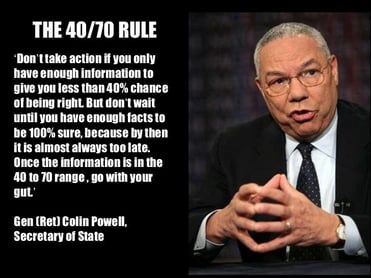 General Colin Powell coined the P = 40 to 70 rule. Powell believed making decisions with less than 40 percent of the information is just guessing, and waiting until you have more than 70 percent is delaying. We’ll share what the best salespeople do to own the flow of information, and limit exploration next blog.
General Colin Powell coined the P = 40 to 70 rule. Powell believed making decisions with less than 40 percent of the information is just guessing, and waiting until you have more than 70 percent is delaying. We’ll share what the best salespeople do to own the flow of information, and limit exploration next blog.
Building an enduring great organization requires disciplined people, disciplined thought, disciplined action, superior results, producing a distinctive impact on the world.
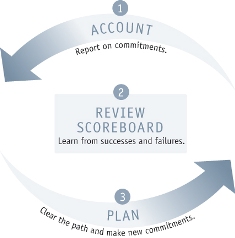 Discipline sustains momentum, over a long period of time, laying the foundations for lasting endurance.
Discipline sustains momentum, over a long period of time, laying the foundations for lasting endurance.
A winning habit starts with 3 Strategic Disciplines: Priority, Metrics, and Meeting Rhythms. Forecasting, accountability, individual, and team performance improve dramatically.
Meeting Rhythms achieve a disciplined focus on performance metrics to drive growth.
Let Positioning Systems help your business achieve these outcomes on the Four most Important Decisions your business faces:
|
DECISION |
RESULT/OUTCOME |
|
PEOPLE |
|
|
STRATEGY |
|
|
EXECUTION |
|
|
CASH |
|
Positioning Systems helps mid-sized ($5M - $500M+) businesses Scale-UP. We align your business to focus on Your One Thing! Contact dwick@positioningsystems.com to Scale Up your business! Take our Four Decisions Needs Assessment to discover how your business measures against other Scaled Up companies. We’ll contact you.
NEXT BLOG – The Jolt Effect: Own the Flow of Information – Limit Exploration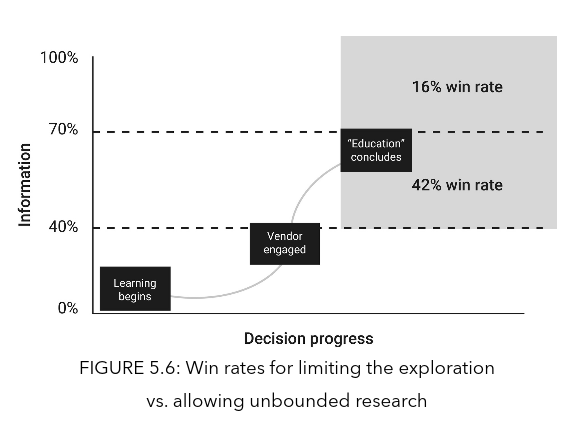






.jpeg?width=150&height=135&name=Hand%20with%20marker%20writing%20the%20question%20Whats%20Next_%20(1).jpeg)

